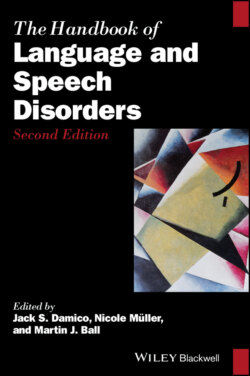Читать книгу The Handbook of Language and Speech Disorders - Группа авторов - Страница 52
3.3.8 Word and Sentence Processing
ОглавлениеA relatively large percentage of research at the word (in the sense of vocabulary) and sentence levels involves children. Whereas children with CIs have a reduced receptive and expressive vocabulary compared to their NH peers, as was found in a recent meta‐analysis (Lund, 2016), there is some evidence that grammatical skills lag behind their lexical skills. For instance, in a sentence repetition task, they substituted more words and omitted more articles than hearing‐age matched NH controls, whereas their vocabulary was normal (Caselli, Rinaldi, Varuzza, Giuliani, & Burdo, 2012). Half of the 70 school‐aged Dutch children with CIs studied by Boons et al. (2013) had developed linguistic skills on a par with their NH peers. Whereas vocabulary was on average at age‐appropriate levels, CI children had difficulty with salient morphology (for example, the comparative ‐[ər] and the superlative ‐[stə]), with formulating sentences according to the CELF test (creating sentences using word and picture cues; Kort, Compaan, Schittekatte, & Dekker, 2010) and with retelling stories based on picture cues. Four‐ to seven‐year‐old children with CIs had a mean length of utterance (MLU, a measure of grammatical complexity) in spontaneous speech below the norm. At the age of seven, this was still 55%. Moreover, they had more errors in finite verb morphology and subject–verb agreement. Age at implantation, but not hearing level, was found to predict results. Scores did not clearly improve over time, except for finite verb morphology. This indicates that CI children have extended delay in their grammatical development.
In a study by de Hoog et al. (2016), of 39 CI children, 12.9% performed at a level that is comparable to the norm on picture naming, which is a test of expressive vocabulary, and 10.4% on picture selection, which tests receptive vocabulary. For sentence completion, testing morphosyntactic proficiency (e.g., plurals and verb tenses), this was 20.7% and in picture selection, testing grammatical knowledge in word order tasks, they scored 28.4%. The authors note that the relatively low scores may be due to the fact that only a little over 51% of their cohort used spoken language in education. Lexical language skills were best predicted by age at testing, phoneme perception abilities, and auditory word closure scores, which involves identifying words based on partial information. The best predictors of morphosyntactic skills were the lexical skill scores, auditory memory for words, and auditory word closure. In a recent review, Ruben (2018) concluded that many, but not all, CI children reached age‐appropriate receptive and expressive language skills between 3 and 10 years after implantation, with more promising results for earlier implantations. This conclusion is seemingly at odds with Boons et al. (2013), and highlights the need for further thorough investigation of the effects of CI listening on language development.
In conclusion, the above studies show that CI children have delayed development of many aspects of morphosyntax, despite a relatively normal vocabulary. Their development is influenced by more fundamental abilities such as phoneme perception and auditory memory, as well as by age at implantation. Existing literature indicates that they have a reasonable chance of catching up with their NH peers several years after implantation.
